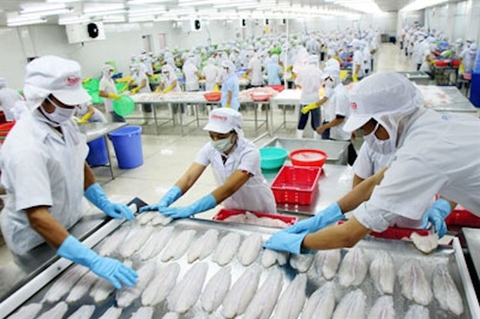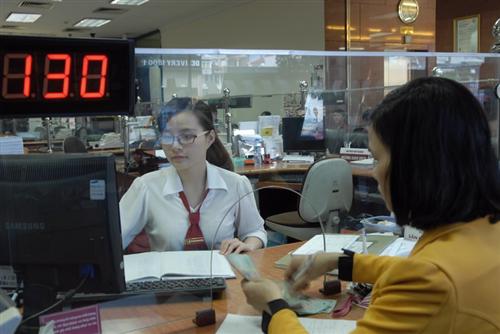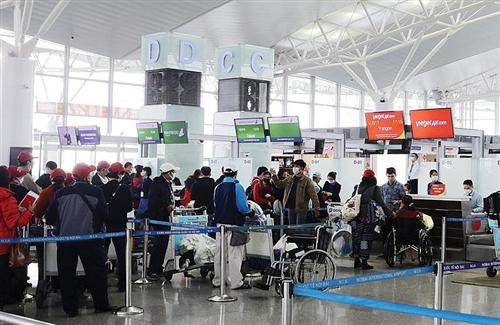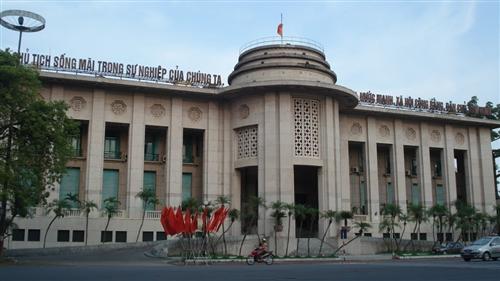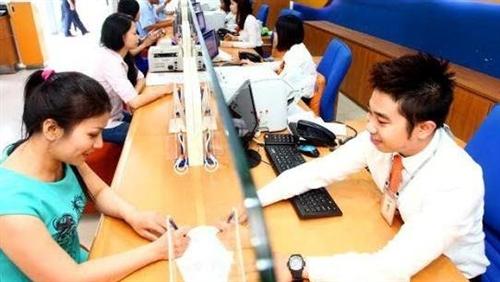EVFTA lends newfound vigour to banking sector
EVFTA lends newfound vigour to banking sector
The ratified EU-Vietnam Free Trade Agreement is expected to bring a historic change in the Vietnamese banking sector, but also sets sizeable challenges for both foreign and local lenders before they can receive good returns on investment.
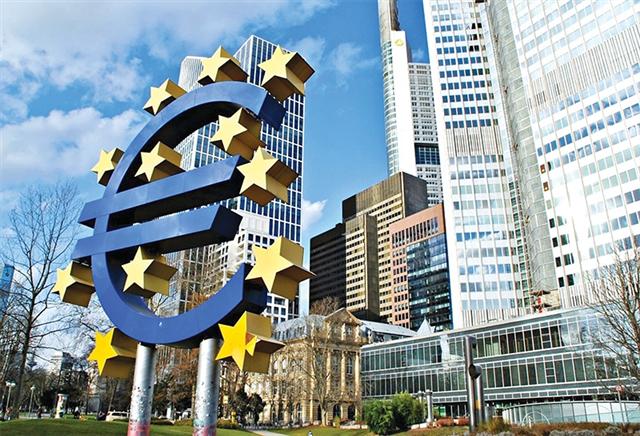
European lenders have had their own problems, but can still bring a wealth of prospects for Vietnam’s finance arena, Photo Le Toan
|
Bank mergers could get speedier under the EU-Vietnam Free Trade Agreement (EVFTA), with regulators changing policies that had deterred deals, lifting the cap for foreigners on two local banks to 49 per cent.
That stance could potentially help fuel more consolidation, though it has also raised concerns of valuations and conflicts arising along the way.
“This is anticipated to improve the diversity of Vietnam’s banking industry in at least the next five years,” said Phan Dung Khanh, investment director at Maybank Kim Eng Securities. “European lenders may have relatively better experience with a wide range of products and services, thus the entrance of such foreign players to Vietnam will increase local competition. This represents a true win-win for businesses and consumers, in the form of greater services and increased competitiveness.”
Vast prospects
There is no doubt that foreigners require a certain level of detail and specificity of due diligence process, as Vietnamese banks have varying levels of scale, capacity, risk management, operation standards, and administration.
For instance, Vietnamese lenders are now applying or attempting to satisfy Basel II, whereas the EU is using Basel III and even preparing for Basel IV.
The State Bank of Vietnam (SBV) and the Ministry of Finance will eye criteria of non-performing loans (NPLs), core credit operations, and how banks match with the SBV’s requirements, among others.
For instance, loan life coverage ratios (LLCR) are an essential catalyst for overseas financiers to jump in.
Some banks have recorded impressive LLCR percentages, including Asia Commercial Bank (ACB), BAC A BANK, and Military Bank (MB), while a few are still struggle with below-50-per-cent ratios, such as VIB, SeABank, VPBank, and Saigonbank. The higher the LLCR, the higher the probability that banks recover from downturns.
On the other hand, foreigners are placing their attention on the most closely-watched measures of lenders’ profitability: net interest margins (NIM).
A bank’s NIM takes into account how much the lender earns from putting deposits into loans or securities.
In this regard, VPBank, VIB, MBBank, and Techcombank are among the most promising candidates.
While ACB, MB, and Techcombank reported record low NPL ratios, VIB and VPBank are winners in the Basel II competition.
“Overseas investors, obviously, would take these advantages seriously since they could gauge how banks boost capital cushion and prepare to weather downturns without taxpayer bailouts,” Andreas Stoffers, country director at Friedrich Naumann Foundation, told VIR.
Besides state-owned banks, Techcombank, MB, VPBank, and VIB have the highest ratings among 31 lenders, as reported by global agency Moody’s, thanks to their performance in baseline credit assessment, counterparty risk assessment, currency issuer, and currency deposits.
Experts at brokerage Vietnam Investment Securities are optimistic of VIB, VPBank, Techcombank, and ACB being the promising candidates for the deals.
More detailed guidance on how much capital regulators want banks to hold could also give greater clarity on dividend payments.
Stoffers of Friedrich Naumann Foundation also noted foreign financiers would stay away from banks with less advanced experience since they are vulnerable to risks.
“Bolstering investor confidence in bank balance sheets, culture diversity, and a handful of technology advancements could also help spur a wave of merges, particularly from Europe’s fragmented banking sector,” said Stoffers.
Challenges
Industry insiders said that investors often need a longer time to penetrate the market. “Notwithstanding the regulatory relaxations, European banks might still face various obstacles including inter-provincial expansion, product approval, and distribution through banking channels,” Khanh at Maybank told VIR. “In fact, the number of European banks in our countries is shrinking, which is in stark contrast to greater participation from banks in other Asian countries.”
While South Korean, Japanese, or Chinese lenders are gearing up to enter Vietnam’s financial market thanks to the similarities among Asian nations, Western players still remain a modest part of the game. In worst-case scenarios, some have left or divested their shares in the country.
“European banks could have followed the banking sector in Vietnam but they still remain on the sidelines thus far. It is because plenty of prospective deals only look at the two banks on paper, but it is without taking each party’s people or culture into account,” said Stoffers.
Last March, Hanoi-based private creditor SeABank announced that its French strategic partner SocieteGenerale Group (SocGen) offloaded a 20 per cent stake after a 10-year alliance. The sale was part of SocGen’s recent strategy of exiting non-core markets in all of Asia to consolidate its positions in places where it is already strong.
French bank BNP Paribas previously divested its entire 18.68 per cent stake in Orient Commercial Joint Stock Bank, ending a decade-long partnership in 2017.
Last week, international lender HSBC announced a sweeping overhaul of its business after witnessing a 53 per cent fall in net profit, which is believed to be hit by a goodwill impairment of $7.3 billion. The bank is mulling 35,000 job cuts and global business withdrawals that may affect its Vietnamese subsidiary. It said it expects to incur around $7.2 billion of costs related to restructuring in the next few years.
Back in 2017, it was rumoured that insufficient control was the main reason that saw HSBC offload its shares in Techcombank. While HSBC shareholders expected to receive dividends, Techcombank did not pay any dividends for six consecutive years after 2010 in a bid to further raise charter capital.
Last year, Standard Chartered divested its entire 8.75 per cent of shares in ACB after 12 years of collaboration. Standard Chartered had previously withdrawn its representatives from ACB’s board of directors for unspecified reasons.
Germany’s largest lender Deutsche Bank, which entered Vietnam in 1992, swung to a $5.8 billion loss in 2019. After a failed attempt to merge with its rival Commerzbank AG last year, Deutsche Bank moved to shrink and reorganise its global investment bank and specialise in serving European clients.
Norges Bank from Norway currently holds 1.71 per cent of Techcombank’s shares, and Commonwealth Bank of Australia acquires 20 per cent of VIB. But it is still very soon to say whether they will expand their footprint.
Meanwhile, Barclays – a British lender which joined into a financial partnership in Vietnam more than a decade ago – has been caught up in a number of scandals and investigations in recent years. The inevitable headlines drowned out some modestly good news in the bank’s financial results, thus chances are low that the bank will cash in on Vietnamese banks.
According to Nguyen Thuy Duong, chairwoman of EY Vietnam, many overseas investors deem that information disclosure in Vietnam is not transparent or clear enough. While for almost all leading financial markets information transparency has been a prerequisite, investors from the United States, the United Kingdom, or Australia might face great challenges to understand Vietnamese accounting standards due to its significant deviation from IFRS global standards.
Oanh Nguyen, partner at Baker McKenzie Vietnam, said that many domestic banks refuse to let foreign partners do due diligence on their business, which deters many interested suitors.
Last December, Moody’s dealt a fresh blow to Vietnam’s financial sector by downgrading the outlook of 18 banks, a move which set local lenders in a riskier position as foreigners are less inclined to buy into downgraded credit unions.
However, a handful of European banks are also struggling, with low interest rates that have been hammering their profitability for several years. So, before they cash in on Vietnamese lenders, they have to make sure it is worth every penny.
|
The EU-Vietnam Free Trade Agreement and the EU-Vietnam Investment Protection Agreement, which were ratified by members of the European Parliament two weeks ago, will both support European giants’ ambition in Vietnam. Accordingly, Vietnam will lift some limits on foreign ownership in two local banks to 49 per cent in the next five years, with the exception of the four joint-stock commercial banks in which the state still holds the controlling stake. However, after the five-year-period, this relaxed foreign ownership limit of 49 per cent would be no longer applicable. The current rate is just 30 per cent. “Vietnamese policymakers should take it really serious in this regard since finance is a sensitive sector. The new approach, though a bit cautious, is appropriate,” explained Nguyen Thi Thu Trang, director of the WTO Centre at the Vietnam Chamber of Commerce and Industry. “Under the new legal regime, both international and domestic lenders will be more focused on their business operational capability, quality, and efficiency.” |





